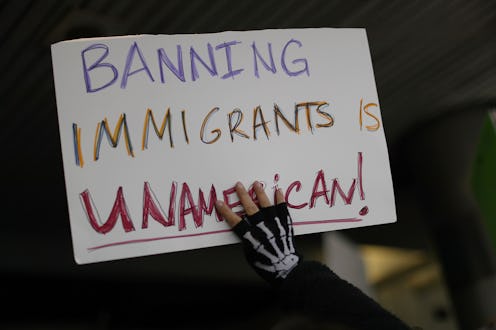News
The Weird Exception To The Travel Ban

In the latest episode in the thorny history of American immigration law, the Supreme Court has partially revived the travel ban ordered by President Donald Trump. The court's decision means that unless a person from one of six Muslim-majority countries, mentioned previously in the executive order, has relations or a specific stated reason to be in the U.S., they won't be able to travel here. So while it may seem strange to make exceptions to a travel ban that's meant to completely stem the flow of travelers from Muslim-majority nations, the decision to do so falls neatly in line with America's idiosyncratic immigration laws, historically speaking.
In the Supreme Court's Monday decision, the justices decided that only those from six Muslim-majority countries with a "credible claim of a bona fide relationship with a person or entity in the United States" will be allowed to enter. This also includes students accepted to American schools and employees beginning work for America-based companies.
But based on historical precedent, this opinion, which the justices left unsigned, is far less harsh than what previous Congressional acts have done when worried about a certain kind of people's immigration to the U.S. Beginning in 1875, the American government imposed a number of harsh restrictions on a foreign national's entrance into the U.S. based on that person's nationality. These laws, prompted primarily by Americans' anxieties regarding immigration from Eastern Hemisphere countries, included the Asian Exclusion Act and the Chinese Exclusion Act.
After the turn of the century, discriminatory immigration laws began to focus more on the fact that European immigration had shifted from northern and western countries to southern and eastern ones. The 1921 Emergency Quota Act and the Immigration Act of 1924 established severe quotas to limit the number of foreign-born in the United States. The 1924 act decreased the number of immigrants allowed into the country per year to 165,000; it also continued to ban Asian immigration.
But after World War I and World War II, the United States began to soften its stance toward immigration, ever so slightly. The Immigration and National Act of 1952 removed race from being a basis of exclusion from entering the United States. The act, however, still allowed the government to exclude people based on their political beliefs and mental health. The 1965 amendment to this 1952 law is perhaps the intellectual basis for the Supreme Court's decision to allow people from those six Muslim-majority countries to enter the U.S., despite Trump's executive order. The act said that family reunification should be one of the most important considerations when determining whether or not a person could come to the United States.
It's important to note, however, that these post-war laws were looking at longer-term residency in the United States, whereas Trump's travel ban intends to restrict as much movement, permanent or temporary, as possible.